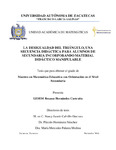
Please use this identifier to cite or link to this item:
http://ricaxcan.uaz.edu.mx/jspui/handle/20.500.11845/1213| Title: | La desigualdad del triángulo, una secuencia didáctica para alumnos de secundaria incorporando material didáctico manipulable |
| Authors: | Hernandez Castruita, Roxana |
| Issue Date: | 15-Dec-2016 |
| Publisher: | Universidad Autónoma de Zacatecas |
| Abstract: | En este documento se aborda una de las problemáticas que tienen los estudiantes de secundaria referente a la dificultad en el aprendizaje de algunos conceptos y propiedades geométricas. Para atender dicha problemática se propone el rediseño de una secuencia didáctica (Espinoza, H., García, S. y García, M. A., 2000, pp. 94-95) para el estudio de la desigualdad del triángulo. Dicha secuencia incorpora material didáctico manipulable, procurando que éste actúe como mediador entre el concepto y el aprendizaje de los estudiantes. El marco teórico en el cual se encuentra sustentada nuestra investigación, es la Teoria de Situaciones Didácticas desarrollada por Brousseau durante los años setenta. La metodología que se utiliza es la Ingeniería Didáctica desarrollada por Artigue, la cual propone cuatro fases: análisis preliminares, concepción y análisis a priori, experimentación y análisis a posteriori y validación. Se concluye que la implemetación de material didáctico para el tema de la desigualdad del triángulo tuvo un impacto positivo en el en proceso de aprendizaje de los alumnos, ya que se logró que la mayoría del grupo aprendiera el tópico matemático y que mediante éste, pudieran comprobar sus respuestas y dar argumentos. |
| Description: | In this document one of the problems with high school students regarding the difficulty in learning concepts and geometrical properties addressed. To address this problem the redesign of a didactic sequence for the study of the proposed triangle inequality. This sequence includes manipulatives, ensuring that it acts as a mediator between the concept and student learning. The theoretical framework which is underpinned our research, is the theory of didactic situations developed by Brousseau during the seventies. The methodology we use is developed by the Engineering Teaching Artigue, which proposes four phases: preliminary analysis, design and a priori analysis, experimentation and subsequent analysis and validation. Further we conclude that the implemetation of teaching materials for the subject of the triangle inequality had a positive impact on the learning process of students, as it was achieved that most of the group to learn the mathematical topic and that through this, could prove your answers and give arguments. |
| URI: | http://ricaxcan.uaz.edu.mx/jspui/handle/20.500.11845/1213 |
| Other Identifiers: | info:eu-repo/semantics/publishedVersion |
| Appears in Collections: | *Tesis*-- UA Matemáticas |
Files in This Item:
| File | Description | Size | Format | |
|---|---|---|---|---|
| 2016 Castruita, R..pdf | Tesis de Castruita 2016 | 4,02 MB | Adobe PDF |  View/Open |
This item is licensed under a Creative Commons License
